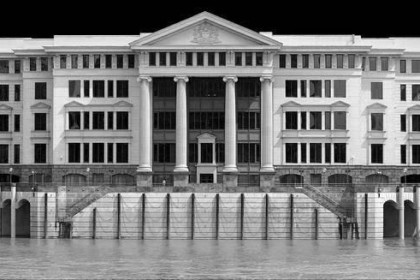London
The Vintners Guild Hall project involved an addition to a historically significant building on the River Thames in London, England. Situated within the “City Proper,” the square mile that includes the Houses of Parliament, Westminster Abbey, St. Paul’s Cathedral, the Tower of London, and the Old Bailey, the London Planning Commission instituted a search for stone comparable in quality to its own high-demand Portland limestone, an Oolitic deposit similar in its buff color to Indiana limestone. Indiana limestone has the additional advantage of having a bedding pattern that is unaffected by erosion factors.
Bybee Stone Company delivered the perfect stone and more. According to Steve Hollick of London-based contractor W.E. Grant & Co., Britain's Prince Charles had urged a revival of classical architecture within City Proper, and the magnitude and prestige of the project was of indescribable significance. “Fortunately, Indiana has both the stone and the craftsmen, the combination required to do the project,” he said.
The Vintners’ Company originated as one of the London guilds of the medieval ages, meeting at their local church, St. Martin in the Vintry. Their first charter was issued July 15, 1363, and allowed the Vintners to preside over the wine trade – which, between the years 1446 and 1448, for instance, made up almost a third of England’s entire import trade. Through the centuries, the Vintners maintained estates and charities and have endured political changes, and today the Vintners enjoy a renewed interest and support for the trade. A new charter was granted Aug. 20, 1973.
The Vintners have an interesting historical connection to swans, dating at least from the mid-1400s. Swans were prized – both for meat and for their quills, used for writing – and could only be owned by freeholders of land or by “prescription,” a term similar to “grandfathered” in American terminology. Therefore, the Vintners Place addition included two large swans carved in relief by Bybee Stone Company for its River Thames dock – the entrance where, historically, royalty have disembarked to enter Vintners Place.

Architect: Winney Mackey & Lewis
Contractor/Mason: W.E. Grant & Company
Cubic Feet: 18,000